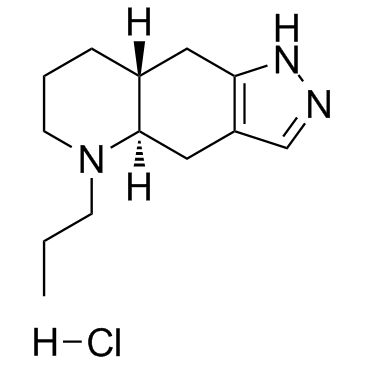(-)-Quinpirole hydrochloride

(-)-Quinpirole hydrochloride structure
|
Common Name | (-)-Quinpirole hydrochloride | ||
|---|---|---|---|---|
| CAS Number | 85798-08-9 | Molecular Weight | 255.78700 | |
| Density | 1.07g/cm3 | Boiling Point | 383.9ºC at 760 mmHg | |
| Molecular Formula | C13H22ClN3 | Melting Point | N/A | |
| MSDS | USA | Flash Point | 186ºC | |
|
Chemical genetics reveals a complex functional ground state of neural stem cells.
Nat. Chem. Biol. 3(5) , 268-273, (2007) The identification of self-renewing and multipotent neural stem cells (NSCs) in the mammalian brain holds promise for the treatment of neurological diseases and has yielded new insight into brain cancer. However, the complete repertoire of signaling pathways ... |
|
|
Regulation of synaptic MAPK/ERK phosphorylation in the rat striatum and medial prefrontal cortex by dopamine and muscarinic acetylcholine receptors.
J. Neurosci. Res. 93 , 1592-9, (2015) Dopamine and acetylcholine are two principal transmitters in the striatum and are usually balanced to modulate local neural activity and to maintain striatal homeostasis. This study investigates the role of dopamine and muscarinic acetylcholine receptors in t... |
|
|
Loss of feedback inhibition via D2 autoreceptors enhances acquisition of cocaine taking and reactivity to drug-paired cues.
Neuropsychopharmacology 40(6) , 1495-509, (2015) A prominent aspect of drug addiction is the ability of drug-associated cues to elicit craving and facilitate relapse. Understanding the factors that regulate cue reactivity will be vital for improving treatment of addictive disorders. Low availability of dopa... |
|
|
Overinhibition of corticostriatal activity following prenatal cocaine exposure.
Ann. Neurol. 73(3) , 355-69, (2013) Prenatal cocaine exposure (PCE) can cause persistent neuropsychological and motor abnormalities in affected children, but the physiological consequences of PCE remain unclear. Conclusions drawn from clinical studies can sometimes be confounded by polysubstanc... |
|
|
Adaptation of NS cells growth and differentiation to high-throughput screening-compatible plates.
BMC Neurosci. 11 , 7, (2010) There is an urgent need of neuronal cell models to be applied to high-throughput screening settings while recapitulating physiological and/or pathological events occurring in the Central Nervous System (CNS). Stem cells offer a great opportunity in this direc... |
|
|
Light-dependent translocation of arrestin in rod photoreceptors is signaled through a phospholipase C cascade and requires ATP.
Cell. Signal. 22(3) , 447-56, (2010) Partitioning of cellular components is a critical mechanism by which cells can regulate their activity. In rod photoreceptors, light induces a large-scale translocation of arrestin from the inner segments to the outer segments. The purpose of this project is ... |
|
|
Quinpirole and 8-OH-DPAT induce compulsive checking behavior in male rats by acting on different functional parts of an OCD neurocircuit.
Behav. Pharmacol. 24(1) , 65-73, (2013) This study investigated whether the serotonin 5-HT1A receptor agonist 8-hydroxy-2-(di-n-propylamino) tetralin (8-OH-DPAT) can induce compulsive checking in a large open field, as does the dopamine D2/D3 receptor agonist quinpirole. To induce compulsive checki... |
|
|
Different contributions of dopamine D1 and D2 receptor activity to alcohol potentiation of brain stimulation reward in C57BL/6J and DBA/2J mice.
J. Pharmacol. Exp. Ther. , (2014) C57BL/6J (C57) and DBA/2J (DBA) mice respond differently to drugs that affect dopamine systems, including alcohol. The current study compared effects of D1 and D2 receptor agonists and antagonists, and the interaction between D1/D2 antagonists and alcohol, on... |
|
|
Chronic Δ⁹-tetrahydrocannabinol exposure induces a sensitization of dopamine D₂/₃ receptors in the mesoaccumbens and nigrostriatal systems.
Biol. Psychiatry 37(11) , 2355-67, (2012) Δ⁹-tetrahydrocannabinol (THC), through its action on cannabinoid type-1 receptor (CB₁R), is known to activate dopamine (DA) neurotransmission. Functional evidence of a direct antagonistic interaction between CB₁R and DA D₂-receptors (D₂R) suggests that D₂R ma... |
|
|
The effect of cholestasis on rewarding and exploratory behaviors induced by opioidergic and dopaminergic agents in mice.
Arch. Iran. Med. 15(10) , 617-24, (2012) Several investigations have indicated that cholestasis decreases opioid receptor expression in the brain following increased opioidergic neurotransmission. The opioidergic system plays an important role in regulation of reward circuits that may be produced vi... |